Japan
Wood Products Prices
Dollar Exchange Rates of 25th
Oct
2023
Japan Yen 151.00
Reports From Japan
Tax cuts to help
households
The government has decided on a temporary reduction in
income tax to help households. If agreed the tax cut could
be for one year and a separate programme will help low-
income earners who are already exempt from taxation.
Critics question the effectiveness of a tax cut as a means to
address rising prices of everyday goods and cite the
lengthy process and legislative work that will be required
to implement the scheme. It is anticipated it will take until
June 2024 to have all the procedures in place.
See:
https://mainichi.jp/english/articles/20231020/p2g/00m/0na/065000c
Tourism and domestic demand drives growth
The Bank of Japan (BoJ) recently raised its forecast for
economic growth in six of the nation's nine regions.
Growth was helped by stronger domestic demand (despite
inflation) and the rise in foreign tourist arrivals.
The Kanto-Koshinetsu area centered on Tokyo is among
the six that saw an upgrade. All nine regions reported that
their respective economies had been either picking up or
recovering moderately. Private consumption has been
supported by pent-up demand for services after the
removal of antivirus restrictions.
See:
https://mainichi.jp/english/articles/20231019/p2g/00m/0bu/037000c
Relief as exports rise
Japan’s exports grew for the first time in three months in
September but the conflict in the Middle East and
slowdown in China could undermine further expansion.
Exports grew 4.3% in September from a year earlier
according to the Ministry of Finance.
Exports were driven by car shipments, which account
for
18% of overall exports, offsetting declines in exports of
chip-related products. China-bound food exports,
including fishery products tumbled 58% year-on-year in
September due to its ban on Japanese food imports on
worries about water released from the Fukushima nuclear
power plant.
Exports to the US rose 13% year-on-year led by hybrid
vehicles, mining and construction machinery and motors.
The trade data also showed imports fell 16% in the year to
September.
See:
https://japannews.yomiuri.co.jp/news-services/reuters/20231019-144156/
In related news, according to the Ministry of
Economy
Trade & Industry (METI) retail sales increased 7% year-
on-year in August 2023, unchanged from the revised
figure for the previous month and exceeding the consensus
forecast for a 6.6% growth. The latest rise was the 18th
consecutive month of expansion in retail sales and the
fastest pace since February as consumption continued to
recover from the pandemic-induced slump.
By sector, sales for food retailers advanced the most
(9.4%), followed by automobile retailers (9.0%), fuel
retailers (7.9%), various product retailers (7.2%), other
retailers (6.8%), machine equipment retailers (5.6%),
pharmaceuticals and cosmetics (3.9%), non-store retailer
(3.5%) and textile, apparel & accessories retailers (0.9%).
See:https://www.meti.go.jp/english/statistics/tyo/syoudou/index.html
Measure of current economic conditions
A report from the Cabinet Office shows Japan's coincident
indicator index rose for the first time in four months in
October as economic activity expanded. The October
index of coincident economic indicators, which consists of
a range of data including factory output, employment and
retail sales, gained from the previous month.
Japan's index of coincident indicators measures current
economic conditions and offers an insight to the amplitude
of the fluctuations of economic activities. The composite
indices are constructed by aggregating the changes in a
range of selected economic series.
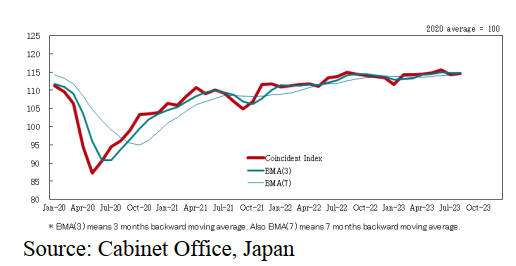
Wage increases – plan needed for small companies
In fiscal 2021 over 60% of small companies in Japan did
not declare a profit so did not pay any tax which means
plans by the government to offer tax relief to companies
that raise wages will not help workers in small companies.
Small and midsize businesses make up more than 99% of
companies in Japan.
Fueling interest in the expansion of appropriate and
meaningful tax incentives for companies is the growing
concept of "human capital management," which sees
employees as capital and their education and training as an
investment to boost productivity.
See:
https://asia.nikkei.com/Spotlight/Datawatch/Japan-fails-to-boost-wages-with-tax-break
Cost-push inflation to slow in coming months
Consumer prices rose just 3% in September, the slowest
pace in about a year as imported energy costs dipped but
this was above the Bank of Japan’s (BoJ) 2% target for the
18th straight month. Much of the pressure on prices was
because the weak yen has pushed up the cost of imports.
The BoJ expects cost-push inflation to slow in the coming
months. A fresh outlook report will be released at the end
of a two-day policy meeting in late October.
See:
https://mainichi.jp/english/articles/20231020/p2g/00m/0bu/020000c
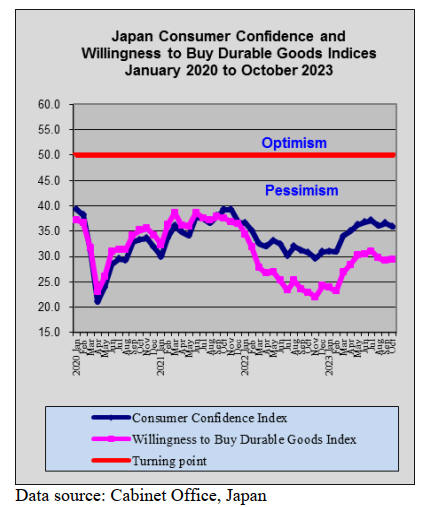
Tiny homes attract interest from older generation
In 2021 a start-up company based in Nishinomiya, Hyogo
Prefecture announced plans to develop a micro house
using a 3D printer and since then the company has
received many inquiries. The homes have a floor space of
just 10 square metres and are priced at between 3-4
million yen (US$20-25,000).
Kaito Ogata, the chief technology officer, said the
company initially aimed to offer affordable housing to
young people because of surging house prices in urban
areas. The company was surprised that many of the
inquiries were from people aged 60 or older.
When interviewed some of the older people said they
found it too expensive to renovate their aging homes while
others said they were considering buying low-priced
housing because they were refused rental contracts once
they turned 60. Ogata said this exposes the unique
situation Japan’s elderly population face with housing.
See:
https://japannews.yomiuri.co.jp/editorial/political-pulse/20231014-142876/

Interest rate change at BoJ but Yen unresponsive
At its recent policy board meeting the BoJ further
loosened its grip on long-term interest rates by changing
its bond yield control policy and this was interpreted as
another signal that its unique and controversial monetary
stimulus policy may be slowly dismantled.
But, rather than strengthening the yen it actually weakened
after the decision as traders focused on the BoJ's dovish
pledge to "patiently" maintain it current policy.
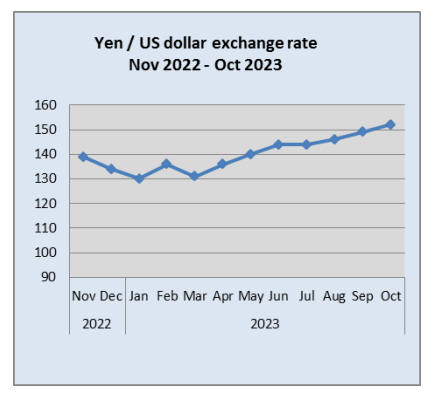

Wooden bedroom furniture (HS940350) imports into
Japan are worth more than all other categories of wooden
furniture and the value of imports has consistently been
higher than all others. Over the past 5 months the value of
wooden bedroom furniture has steadily declined and in
August the value of imports dropped closer to the value of
wooden kitchen furniture and furniture parts.
August wooden office furniture imports (HS 940330)
The value of Japan’s wooden office furniture imports in
August up a massive 56% compared to the unusually low
value of July imports.
In August shippers in China and Malaysia dominated
imports accouting for 44% and 37% respectively of total
imports of wooden office furniture (HS940330). For the
first time shippers in Turkey shipped sufficient for the
country to enter the top 20 shippers but at just 4% of total
imports of wooden office furniture this was small.
Year on year, the value of August 2023 imports of wooden
office furniture was down 14% but compared to the value
of July imports there was a slight increase. The
diversification of sources of wooden office furniture
observed in July appears to have been maintained into
August.
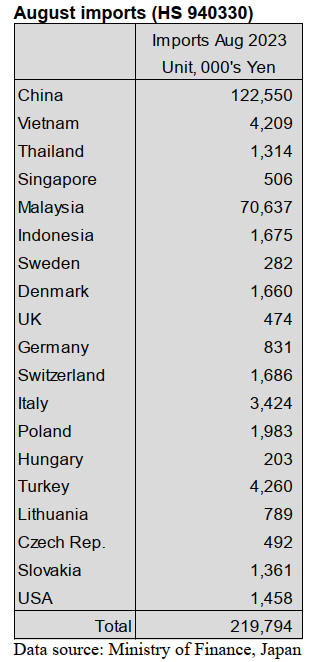
August kitchen furniture imports (HS 940340)
The Philippines and Vietnam together accounted for over
80% of the value of Japan’s imports of wooden kitchen
furniture in August, as was the case in previous months.
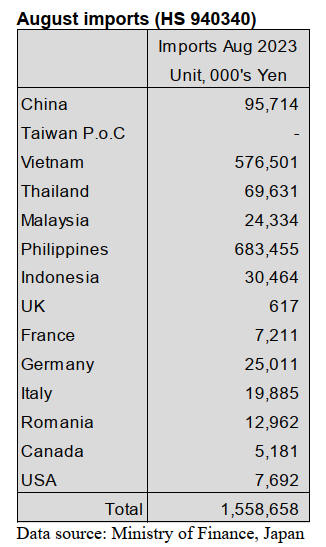
In August, the top four shippers, the Philippines, Vietnam,
China and the EU all recorded a rise in the value of
August arrivals.
Year on year the value of wooden kitchen furniture
imports in August dropped 14% adding to the 28% month
on month decline in July.
In August shipments from the Philippines accounted for
44% of the value of imports of HS940340 with a further
37% coming from Vietnam.
August wooden bedroom furniture imports
(HS 940350)
Since April this year there has been a steady reduction in
the value of Japan’s imports of wooden bedroom furniture.
China and Vietnam were the main suppliers of wooden
bedroom furniture in August, together accounting for over
90% of imports of this category of wooden furniture.
August imports from China were at around the same level
as in July but there was a drop in the value of imports from
Vietnam.
The decline in the value of imports from these two main
shippers disguises the advances made in market share by
some other shippers such as Malaysia and some EU
member states. Having achieved a significant market
share in July (around 7%) Malaysia share of August
arrivals dropped to around 4%.

August wooden furniture parts imports (HS 940391)
Since the third quarter of 2022 there has been a steady
decline in the value of Japan’s wooden furniture parts
imports. Year on year the value of August wooden
furniture parts imports dropped 21% and there was an 8%
decline compared to the value of July imports.
The top suppliers in August were, as in previous months,
China (43%), Indonesia (22%), Vietnam 12% up from the
7% in July) and Malaysia (10%).
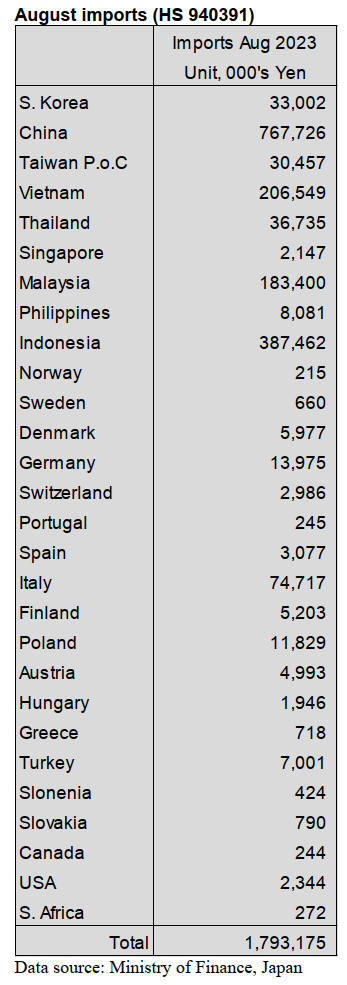
Trade news from the Japan Lumber Reports (JLR)
The Japan Lumber Reports (JLR), a subscription trade
journal published every two weeks in English, is
generously allowing the ITTO Tropical Timber Market
Report to reproduce news on the Japanese market
precisely as it appears in the JLR.
For the JLR report please see:
https://jfpj.jp/japan_lumber_reports/
100% domestic timber for homes
Daito Trust Construction Co., Ltd. started construction
work for apartment houses made of all domestic lumber by
2 x 4 method in Iwate Prefecture.
This is the company’s first to build a house made of all
domestic lumber. In some area, only cedar is used for
studs or other several parts of a house but in this case,
domestic lumber is used for all parts of a house.
Red pine is used for floor joists and taruki. Daito Trust
Construction had been testing the strength of red pine
lumber with the relevant organizations and they confirmed
that the strength of 2 x 4 red pine lumber is good enough.
Kesen Precut Business Cooperative produces 2 x 4 cedar
and red pine lumber and supplies panels.
There are two houses and floor area of one house is about
350 square meters and floor areas of the other house is
about 460 square meters. 2 x 4 and 2 x 6 of cedar lumber
is used for studs of walls, frames and sills. 2 x 4, 2 x 6, and
2 x 10 of red pine lumber is used for floor joists on the
first floor and the second floor. 2 x 4 – 10 cedar and red
pine are used for lintels. 4 x 10 larch structural LVL is
used for beams.
Domestic softwood plywood such as cedar plywood, larch
plywood and red pine plywood are used for the apartment
houses. All lumber is made in Iwate Prefecture. Total
volume of lumber used for one house is 44 cbms except
plywood and the other house is 60 cbms. 50 cbms of red
pine lumber, 51 cbms of cedar lumber and 3 cbms of larch
lumber are used for these two houses.
After the confirmation of the strength on 2 x 4 red pine
lumber last year, Kesen Precut got the JAS certification on
red pine lumber. They except to expand the use of 2 x 4
red pine lumber in Tohoku area.
South Sea logs and lumber
The price of laminated board in South East Asia has been
declining. South East Asian sellers did not lower the price
because demand in Japan was low. Since demand in China
is sluggish, so the South East Asian sellers lowered the
price, which is the similar price of Indonesian Merkushi
pine lumber. Distributors do not purchase new laminated
boards because of low demand and the weak yen in Japan.
Inquiries for South Sea lumber recovered slightly. There
was a certain number of orders for decks when the yen
was 146 yen against the dollar. Also, there was a certain
number of orders for truck bodies. South Sea log for
Keruing lumber has been in short supply. Since production
of truck has recovered, demand of truck body also has
recovered and some trading companies order South Sea
log to manufacturers in Japan because it takes a lot of time
to import South Sea logs form South Asia.
However, the manufacturers in Japan do not have enough
South Sea logs. Therefore, the trading companies imported
8,797 cbms of South Sea log in August by containers in a
hurry. The import cost is rising due to the weak yen
against the dollar.
Short supply of logs
Cedar posts and cypress sills are in short supply in Kanto
area. In Tochigi Prefecture, there are less cypress logs and
an operational rate at plants, which produce cedar post, is
declining. Inquiries to cypress sills and taruki are
increasing instead of Douglas fir lumber. The price of
cedar and cypress logs keep rising but there are still not
many logs. Now, the prices of cedar post and cypress sill
are rising.
Movement of lumber in August and September, 2023 was
sluggish and KD cedar post was 55,000 yen, delivered per
cbm but the price is 60,000 yen, delivered per cbm.
The price of KD cypress sill used to be around 70,000 –
75,000 yen, delivered per cbm in September and the price
is now 80,000 yen, delivered per cbm. The log price kept
rising in August and September but the lumber price did
not rise so the profitability was not good. 3 m cedar log
costs around 11,000 yen, delivered per cbm at the end of
June and it is around 16,000 yen, 45 % up from June.
4 m cypress log was around 16,000 yen at the end of July
and the price increased to around 23,000 yen, 44 % up
from July. Cedar post is around 55,000 yen and cypress
sill are around 70,000– 75,000 yen. Logs started to decline
in July in Tochigi Prefecture. The logs at the market in
September was 30 % less than September, 2022.
Therefore, many lumber plants were losing logs from their
inventory.
Lumber plants are concerned about the movement of
lumber after October and if the price hike of cedar or
cypress lumber did not succeed, it would be difficult to run
the lumber plants. There is a possibility that cedar and
cypress logs will be not enough volume. 3 m cedar log
was around 17,000 yen and 4 m cypress log was around
21,000 cbms in the beginning of this year.
The price of cypress is skyrocketing to be around 30,000
yen, which was the price at the woodshock. However, the
loggers feel dangerous to deliver logs to the log market
because once the log price dropped suddenly in spring.
Cedar log was around 10,000 yen and cypress log was
around 14,000 yen at that time and these low-priced logs
kept for several months.

This is two straight years increasing. Demand for lumber,
plywood and pulp / chip is unchanged from the previous
year but demand of woody fuel is 18 % increased.
Domestic woody fuel is 10 % up and imported woody fuel
is 32 % up from last year. Domestic woody fuel increases
thirteen years continuously.
Imported woody fuel increases by 30 % for two years
continuously so a rate of self-sufficiency in domestic
woody fuel is 40.7 % down for two straight years. Total
demand for woody fuel exceeds 85,000,000 cbms for the
first time in sixteen years. Total demand is 17,390,000
cbms, 18 % up from 2021. In 2021, total starts of owner’s
unit increased about 10 % from 2020 so as the demand of
structural materials increased.
Since the woodshock in spring, 2021 affected lumber and
plywood to be a short supply, there was a movement of
supplying for structural lumber. Then, total demand of
structural lumber and plywood has leveled off from 2021.
Imported woody fuel has been increasing since 2021. In
2021, imported woody fuel was 5,390,000 cbms, 39 %
more than 2020. In 2022, it was 7,130,000 cbms, 32 %
more than 2021.
Domestic woody fuel was 9,350,000 cbms, 5 % up from
2020 and was 10,260,000 cbms, nearly 10 % up from
2021. Imported woody fuel consists of 80 % wooden
pellets, 10 % fuel chips and 10 5 charcoals. Wooden pellet
in 2021 was 70 %. Domestic woody fuel consists of 99 %
fuel chips.
Total demand for structural lumber and plywood is
36,080,000 cbms, 1.1 % less than 2021. A rate of self-
sufficiency in domestic structural lumber / plywood is 49.5
%, 1.5 point up. Total demand for pulp, chip and woody
fuel is 49,010,000 cbms, 7.3 % more than the previous
year. A rate of self-sufficiency is 34.2 %, 1.3 point less
than last year.
Total domestic consumption of total demand 85,000,000
cbms is 34,620,000 cbms. The details are 70 % logs and
30 % woody fuels. The details of imported wood,
50,000,000 cbms are 7 % logs, 20 % lumber, 9 %
plywood, 10 % pulp, 40 % chip and 14 % woody fuels.
|